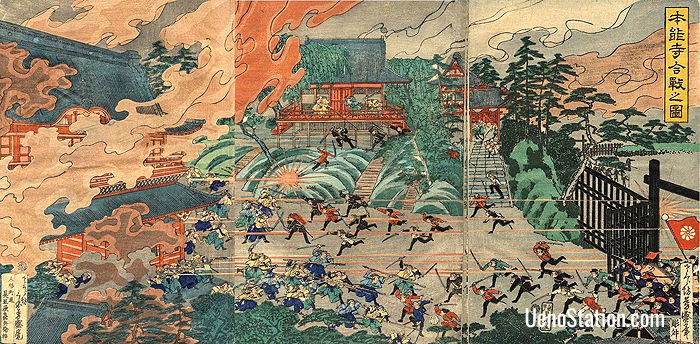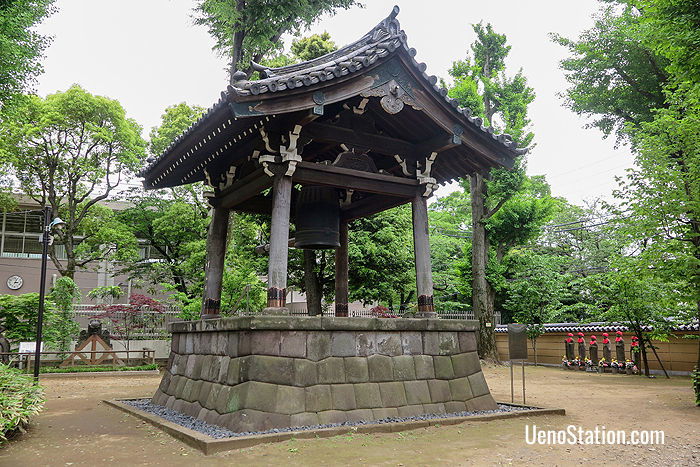Kaneiji is a Buddhist temple in a quiet residential area on the north side of Ueno Park which was once one of the most powerful and wealthy temples in Japan. Previously a massive temple complex with over 30 buildings, the modern Kaneiji Temple is much reduced in size from its historical peak when the temple grounds covered all of the area now occupied by Ueno Park and JR Ueno Station.

The main hall of Kaneiji today
Historically, Kaneiji had a strong relationship with the Tokugawa shogunate. This was a military government, headed by a shogun (or “general”) of the Tokugawa family, that ruled Japan between 1603 and 1867. While the Tokugawa family ruled Japan, Kaneiji remained a rich and powerful temple, but when the Tokugawas fell from power Kaneiji was almost completely destroyed.
The History of Kaneiji
Kaneiji was founded in 1625 by a Buddhist monk named Tenkai, who was an adviser to the first Tokugawa shogun, Tokugawa Ieyasu. Tenkai modeled Kaneiji after Enryakuji, another major temple located on Mount Hiei near Kyoto. Kaneiji’s full official name is actually Toeizan Kaneiji. Toeizan means “Mount Hiei of the East” and it was called Kaneiji because it was built during the Kanei Period (1624-1644).
Because the north-east was considered an unlucky direction, Kaneiji was built north-east of Edo Castle in order to protect the shogun’s residence from any bad luck. The land for the temple was donated by Tokugawa Hidetaka, who would later become the second shogun. Kaneiji’s connection with the Tokugawas remained strong for the next two and half centuries and six Tokugawa shoguns are buried in a nearby cemetery that was once part of Kaneiji’s grounds.

An 1870 painting by Utagawa Yoshimori depicting the Battle of Ueno; Public Domain
Kaneiji’s fortunes changed dramatically in 1868. For some years there had been a power struggle in Japan between forces loyal to the shogunate, and revolutionary forces that wanted a restoration of imperial rule. On July 4th 1868, shogunate forces who had occupied Kaneiji Temple were attacked by the imperial armies. The imperial forces won the battle quite swiftly because they possessed more modern weaponry, but their use of explosive shells caused many fires. Most of the temple buildings and thousands of local homes were destroyed in fires caused by the battle. The Battle of Ueno ended Tokugawa resistance in the city and afterwards most of the land previously owned by the temple was confiscated by the new government. This land was made into Ueno Park in 1873.
Kaneiji Today
Many buildings and structures which now stand isolated in Ueno Park, were once part of Kaneiji Temple. The Bentendo Temple which stands in the middle of Shinobazu Pond, and the Kiyomizu Kannondo Temple inside Ueno Park were both once part of Kaneiji. Kaneiji Temple’s five-story pagoda is now actually located inside the grounds of Ueno Zoo. The current location of Kaneiji Temple itself, was previously the site of a sub-temple.

The main hall of Kaneiji
The main hall is called the Kompon-Chu-do and is dedicated to Yakushi Nyorai, the Buddha of Medicine. Kaneiji’s original main hall was destroyed in the battle of 1868. This building which dates from 1638, was formerly part of Kitain Temple in the city Kawagoe, but was transferred here between 1876 and 1879. Besides the main hall there are some other interesting items on the current temple grounds.

The memorial to Ryoo Dokaku
This is a memorial statue of Ryoo Dokaku (also called Ryoo Zenji), a Zen monk who lived from 1630 to 1707. Originally from Akita in northern Japan, Ryoo Dokaku set up a pharmacy near the Shinobazu Pond, established Japan’s first public library on the grounds of Kaneiji, and donated much money for public works and social welfare.

An oni-gawara or “devil tile” from the original front entrance gate of Kaneiji temple
“Devil tiles” like the one above were meant to scare away evil spirits.

An original ridge tile from the Kompon-Chu-do
The tile from the Kompon-Chu-do was taken down during roof repairs and is now exhibited together with the tile from the gate.

The temple’s copper bell
The copper bell dates from 1681 and was transferred from one of the Tokugawa mausoleums to its current location after the Meiji Restoration in 1868. The bell is a designated Cultural Asset of Taito ward.

Mushizuka-hi: A monument to insects
Mushizuka-hi is a monument to insects which was set up in 1821 to honor the dying request of Sessai Mashiyama (1754 – 1819). Mashiyama was an aristocrat and an artist who created a natural history book of insect sketches called Chuchijo. The monument was erected to console the spirits of the insects that Mashiyama used as models for his sketches.

A statue of Jizo; the Buddhist patron deity of children and travelers
Location
Kaneiji Temple is located to the north of Ueno Park and is a 15 minute walk through the park from JR Ueno Station’s Park Exit. Uguisudani Station on the JR Keihintohoku and Yamanote lines is an 8 minute walk away. Here is a map showing the location.

The entrance to Kaneiji
Article and original photos by Michael Lambe. All rights reserved.
